| Author: | |
| Website: | |
| Page title: | |
| URL: | |
| Published: | |
| Last revised: | |
| Accessed: |
| Year: | 1981 |
| Original platform: | Personal computer |
| Brief description: | Stealth game / action adventure / shooter |
| Number of players: | One |
| Developers/contributors: | Muse Software |
Castle Wolfenstein is variously described as a stealth game, an action-adventure game, and a shooter, and frequently as all three. The term stealth is used to illustrate the fact that the game's main character spends a lot of their time trying to evade capture rather than seeking confrontation. There are however occasions where our hero must resort to the use of weapons, hence the game is also a shooter.
The term action-adventure is a fairly wide ranging one, but it too is appropriate for this game. The game was developed by the Baltimore-based company Muse Software (the name was derived from the term Micro Users Software Exchange) founded in 1978 by Ed Zaron, Silas Warner and Jim Black, who had met whilst working for finance company Commercial Credit.
The company initially set out to write computer games for the Apple II personal computer, but later expanded their ambitions to include other popular personal computer systems, including the Commodore 64, Atari's eight-bit personal computers, and the IBM PC.
The Castle Wolfenstein program itself was primarily the work of Silas Warner, and is noteworthy not only because it is one of the first games of its kind ever written, but also because it broke new ground in terms of what was technically possible for computer games. The game is set in World War II, and the game's main character (who is never actually named) is a prisoner held in a Nazi fortress (the aforementioned Castle Wolfenstein).
The movements and actions of the prisoner are controlled by the player. The object of the game is for the prisoner to negotiate the various levels within the castle, find a set of secret Nazi war plans, and escape. If the prisoner is successful and escapes together with the plans, they are promoted to a higher rank and can play again at a new level of difficulty (there are eight ranks in total).
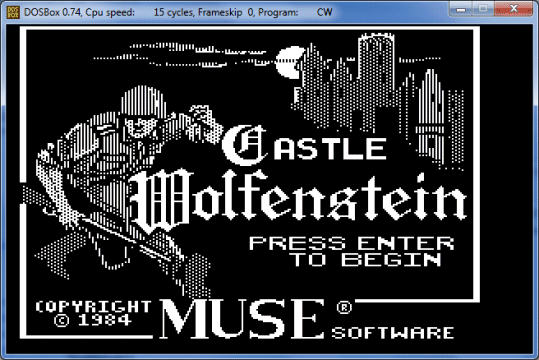
A DOS version of Castle Wolfenstein can be downloaded from the My Abandonware website
(http://www.myabandonware.com/game/castle-wolfenstein-3l#download)
The above screenshot is of the opening screen to the DOS version of Castle Wolfenstein, available from the My Abandonware website. The game can be played on a modern computer using DOSBox, although you will need to adjust the CPU speed within DOSBox to a relatively low value (depending on your computer's processor hardware) in order to get the game to run properly. Once the game is running, the player is given the choice of controlling the game with the keyboard or a joystick.
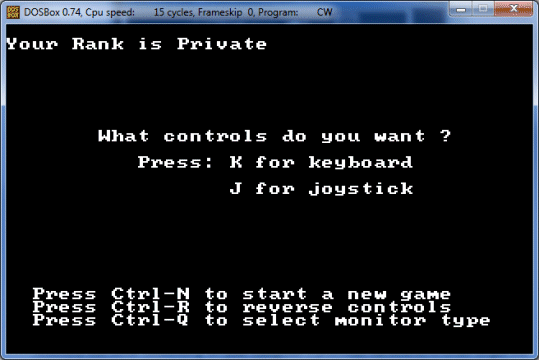
The game can be controlled using the keyboard or a joystick
The game itself utilises a "top down" perspective in the sense that the layout of the rooms in each level are shown from above, although the characters and objects in the game are drawn upright. The graphics in the game are crude by today's standards (the game uses a four-colour CGA palette), but were considered good for their time.
The protagonists in the game come in two different flavours - the guards, who are identified by a large swastika on their uniform, and SS officers, identified by the letters "SS". Of the two, the latter are more difficult to kill (because they have bullet-proof vests) and are generally more dangerous. In addition, the rooms in the various levels frequently feature chests, usually locked, that can contain all manner of things from food and drink to uniforms and explosives. The prisoner is armed with a handgun loaded with ten bullets, given to him by a doomed fellow prisoner.
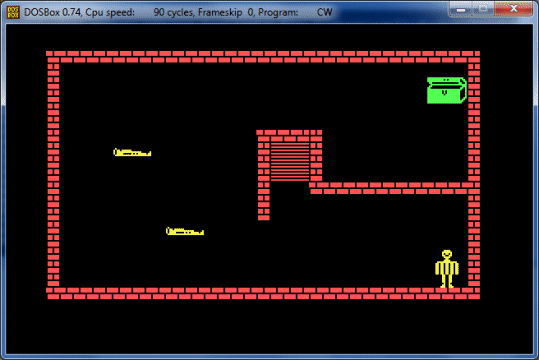
Each room in the castle is depicted using a top-down view
According to the TV Tropes pop-culture wiki, the original version of the game featured the following (more or less) self-explanatory introductory text:
"Welcome to CASTLE WOLFENSTEIN, mate! The Nazis brought you here to get information out of you before they kill you. That's what this place is for - if you listen you can hear the screams. They've already worked me over and I'll never get out alive, but maybe you can with this gun. It's standard issue - each clip holds 10 bullets, and it's fully loaded.
Be careful, mate, because every room in the castle is guarded. The regular guards can't leave their posts without orders, but watch out for the SS stormtroopers. They're the ones in the bulletproof vests and they're like bloody hounds. Once they've picked up your trail they won't stop chasing you until you kill them and you almost need a grenade to do that.
CASTLE WOLFENSTEIN is full of supplies too. I know one chap who found a whole German uniform and almost sneaked out past the guards. He might have made it if he hadn't shot some poor sod and got the SS on his trail. If you can't unlock a supply chest, try shooting it open. Now I wouldn't go shooting at chests full of explosives . . .
One more thing. The battle plans for operation Rheingold are hidden somewhere in the castle. I'm sure you know what it would mean to the Allied high command if we could get our hands on those . . .
They're coming for me! Good luck!
AAIIIIIEEEEEEE . . . . . ."
The prisoner can employ various tactics in order to find the secret plans and make good their escape. The most effective tactic is probably to avoid detection by wearing a guard's uniform, taken either from the body of a dead guard or from one of the chests. Shooting guards is generally a last resort, since it uses up the very limited supply of ammunition and attracts the attention of any other guards in the room.
In addition, killing an SS officer requires multiple shots (although once you have attracted the attention of an SS officer they will follow you from room to room, so you may eventually be forced to resort to violence to get them off your trail). The guards will also surrender to you if you get the drop on them and are aiming your gun at them (even if the gun is empty, since they have no way of knowing whether the gun is loaded or not).
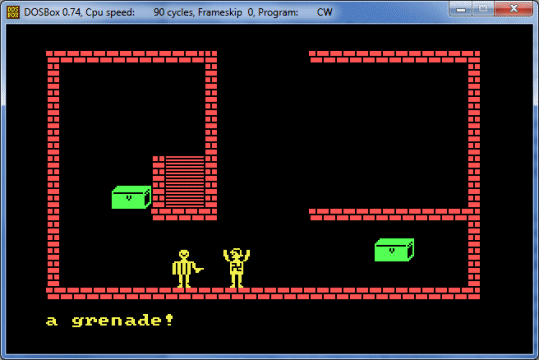
Guards will surrender when threatened with a gun and may be searched
The player can find various useful items as the game progresses, both by opening the chests scattered throughout the castle and by searching any dead or captured guards. The useful items available include hand-grenades, ammunition for the handgun, uniforms, bullet-proof vests, keys, and of course the all-important war plans. Note that the wearing of a guard uniform will fool the ordinary guards, but not the SS officers.
Hand-grenades can be used to kill an SS officer, or to blast through locked doors or internal walls, although like gunshots they will attract unwanted attention. Locked chests can be opened by picking the lock, although this requires a certain amount of time. The process can be speeded up by shooting the lock, but this carries the risk that, if the chest contains explosives, the player will blow themselves up. It also uses up ammunition, and the chest could in fact be empty.
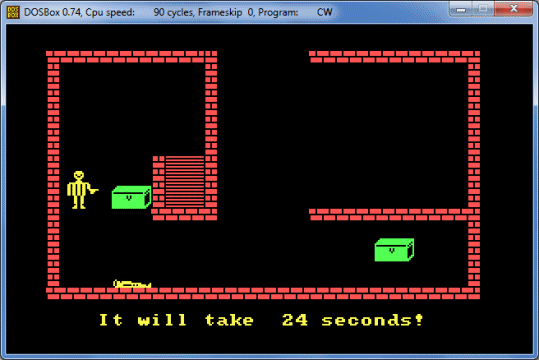
Picking the lock on a chest takes some random amount of time
In addition to useful items, chests can contain things that serve no practical purpose from the point of view of actually playing the game. Examples include Liebfraumilch (a type of German Wine), Schnapps (a somewhat stronger drink), Bratwurst (a type of German sausage), medals, cannonballs, and even Eva Braun's diaries! If the player actually drinks any of the alcohol, they become temporarily disoriented, although eating Bratwurst apparently counteracts the effects of the alcohol.
The player can also be temporarily stunned if they walk into a wall. To add to the game's atmosphere, digitised speech is frequently heard in the form of guards shouting commands in German (or perhaps dying rather noisily). This was a new innovation in computer gaming, introduced by Warner, that utilised the computer's built in speaker (at that time, dedicated sound cards were still a thing of the future).
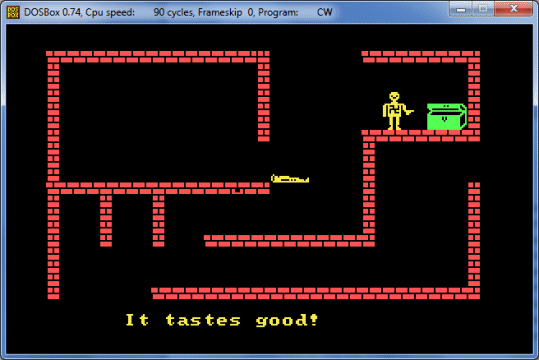
Our hero has found some Bratwurst!
The game ends when the player either manages to escape from Castle Wolfenstein (with or without the plans), or is shot or captured by a guard. In total, there are sixty rooms (or levels) in the castle, spread over five floors. The layout of each room does not change from one instance of the game to the next, but the sequence in which the levels are connected is randomly generated at the start of each game.
Mastering the keyboard controls represents perhaps one of the greatest challenges of the game. The player must memorise eight separate keys just to move around in the various horizontal, vertical and diagonal directions (essentially, equivalent to eight points of the compass). In addition, another eight keys are used to aim the player's weapon in a particular direction. Two more keys are used to halt movement or fire the weapon.
In 1984, Muse Software released a sequel to Castle Wolfenstein called Beyond Castle Wolfenstein, again largely the work of Silas Warner. This time, the object of the game is for our hero to break into Hitler's command bunker complex and locate a bomb hidden somewhere in the complex by allied undercover agents. They must plant the bomb in the vicinity of Hitler and escape from the bunker before the device explodes.
The gameplay is very similar to that of Castle Wolfenstein, with a few new features and improved graphics. The storyline is of course based on the real-life attempt to assassinate Hitler, led by Claus von Stauffenberg, which culminated in failure on July 20th, 1944.
Although initially successful and enjoying a multi-million dollar annual turnover, Muse Software eventually fell victim to the slump in the home computer software market that occurred in the early 1980s. They filed for bankruptcy protection under Chapter 7 in 1985, and eventually ceased trading in 1987. The two Wolfenstein games had left a lasting impression, however, and were the inspiration for id Software's revolutionary 1992 first person shooter Wolfenstein 3D.
Having sought permission to re-use the Wolfenstein name from Silas Warner, id based their game on a similar theme. This time around, the hero has a name - William "B.J." Blazkowicz. In the first episode of the game, Blazkowicz must escape from the Nazi-infested Castle Wolfenstein. Subsequent chapters feature a series of missions carried out by Blazkowicz against the Nazis. Wolfenstein 3D is credited with being the game that both initiated the first person shooter genre of computer games and made them popular. Such is Castle Wolfenstein's legacy.